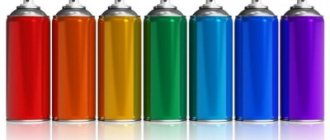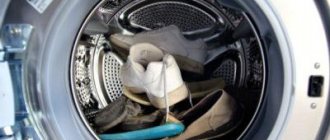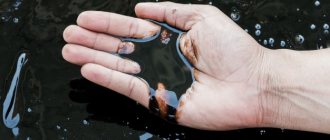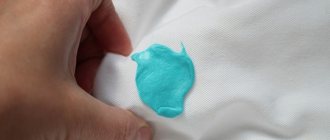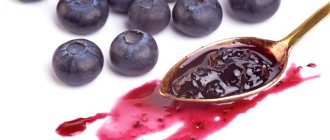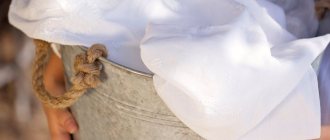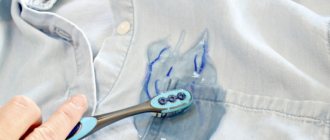If brown marks disappear from the skin on their own over time, then removing them from the fabric is not so easy. The difficulty lies in the chemical composition of the drug, due to which it is practically insoluble in water.
We will tell you in this article how to remove iodine from clothes at home (from white and colored fabrics).
What to do first?
Fresh iodine stains are easier to remove from clothes than dried ones. In addition, if the drop is not quickly removed, it will spread, leak to the opposite side, and penetrate deeply into the fibers of the fabric.
Immediately after spotting:
You need to take off your clothes. Gently blot the damaged area with a napkin.- Cover with starch, soda, and baby powder to absorb any remaining antiseptic.
- For convenience, stretch the cloth over a pan, bucket or jar to prevent iodine from spreading onto the clean cloth.
- If the quality of the material allows, rinse the contamination with boiling water.
- Apply stain remover or home remedy.
If you can’t remove the stains the first time, you should try another method or go to a dry cleaner.
Good to know for housewives
- You should try to wash off iodine stains immediately after they are planted. Over time, blots are more difficult to wipe off, and in the case of iodine, the matter is already difficult.
- To make it easier to clean the stain, the damaged area of fabric should be stretched on a hard flat surface and walked over it with a sponge or brush.
- You can avoid spreading the stain if you immediately apply the cleaning agent around the stain and wash it with gentle circular movements.
- Before using any product to combat antiseptic stains, you need to test its effect on an inconspicuous area of fabric so as not to spoil the item.
- Never use aggressive stain removers on delicate fabrics. The threads may lose their integrity and the color may fade.
- Iodine stains on denim should not be removed with bleach. In order not to spoil the item, it is better to use home remedies.
- After treating fabric with a strong chemical, you should rinse it and use conditioner to get rid of the strong odor.
- Contamination should be cleaned from the reverse side, placing a piece of light cloth on the front for better absorption.
How to remove antiseptic stains using a stain remover?
Household chemicals effectively remove traces of iodine from any material without discoloring or damaging the fabric; they cope well with both fresh and dried, old stains.
| Name | Manufacturer country | Volume | price, rub. |
| Dr. Beckmann "Nature and cosmetics" | Germany | 50 ml | 190 |
| Vanish Gold | USA | 450 ml | 199 |
| Udalix Oxi | Russia | 500 g | 180 |
Gentle products without chlorine-containing bleaching components are suitable for cleaning light-colored, colored and delicate laundry.
Dr. Beckmann
The substances included in the product dissolve coloring pigments without affecting the color and structure of the fabric.
To remove iodine from textiles, you need:
- soak the stain generously with the product;
- leave for 10–30 minutes, depending on the degree of tissue damage;
- blot thoroughly with a napkin;
- wash in the usual way.
The stain remover can be used for dry cleaning, emergency treatment of fresh drops, and removal of old stains.
Vanish Gold
One of the most popular products that effectively deals with stains of any complexity.
Pre-treatment of items with gel will help discolor traces of iodine, and subsequent washing will completely get rid of yellow-brown marks:
- A small amount of the product should be applied to the damaged area.
- Rub the fabric with the bottom of the measuring cap.
- Leave for an hour.
- Wash carefully.
- Without rinsing off the product, put the clothes in the washing machine. Add 100 ml of gel to the drum.
When washing by hand, the same amount of stain remover must be diluted in 4–5 liters of water. If necessary, colored items can be soaked for an additional 1 hour, white items for 5–6 hours.
Udalix Oxi
Universal oxygen stain remover. Depending on the complexity of the stains, it can be used for pre-cleaning damaged areas, soaking, or machine washing.
To remove stains you need:
- 3 tbsp. l. the powder must be diluted in 2 liters of warm water;
- soak clothes for 30–45 minutes;
- Rub the yellow marks well with your hands or a clothes brush;
- machine wash.
The maximum effectiveness of the powder is achieved at a temperature of at least 60 degrees. When washed in colder water, it may not be able to remove stains from delicate clothing.
Using food stain removers
Using stain remover products, you can quickly remove iodine from fabric. The most popular and active of them:
- milk;
- starch;
- lemon juice;
- potato;
- soda + vinegar.
Milk
To remove traces of iodine from clothes using milk, follow the algorithm:
- Soak a cotton swab with milk. Its fat content does not affect the result.
- Apply tightly and wait 30 minutes.
- Rub with laundry soap and rinse.
- Wash in a suitable mode. If the iodine has not completely disappeared, wash it with a stain remover.
Important: in case of significant contamination, pour milk and immerse the product. The method cannot be used to remove fresh, undried iodine drops. Contamination can spread to clean material.
Starch
Reacting with starch, iodine turns blue, after which it is easier to wash off clothes.
In case of a fresh stain, it is necessary to moisten the area with cold water and rub in the starch. As soon as it begins to acquire a blue tint, replace it with a new portion. Repeat the procedure until the contamination completely disappears.
If the stain is old, soak the stained clothing in cold water. Then generously sprinkle the damaged area with starch and rub in gently with a brush. Leave overnight. The iodine stain will turn blue.
Important: this method is suitable for denim material.
Lemon juice
You can remove iodine from white fabric using natural lemon juice or citric acid.
To remove a brown stain, squeeze the juice from a lemon. Freshly squeezed is more effective. The ingress of pulp will not aggravate the process. Without diluting, thoroughly saturate the damaged area. Wait 2 hours. Rinse the problem area. Repeat the entire procedure if necessary. Finally, wash.
Important: with prolonged contact, the acid will damage the material.
Potato
Raw potatoes are a proven remedy from our grandmothers that will help remove iodine stains. You should wash the raw potatoes and cut the tuber into 2 parts. Rub both sides with a cut edge. Gradually, entering into a chemical reaction, the stain will acquire a blue color. After washing the blue discoloration disappears.
Important: to improve the effect, grate the potatoes.
Soda + vinegar
A unique mixture of baking soda and vinegar can remove various types of stains. When these components interact, a neutralization reaction occurs. Thanks to it, it is possible to remove stains from fabric. The method helps in the most advanced cases.
The cleaning algorithm is as follows:
- Sprinkle a generous layer of baking soda onto the stained area.
- Add 1-2 tbsp on top. l. vinegar.
- Leave the item for 2 – 3 hours.
- Carefully wipe off the resulting crust with a brush.
- Rinse under cold water.
Important: baking soda and vinegar can remove stains from white fabrics.
Features for different fabrics
When choosing a product for removing iodine stains, you should take into account the type of material from which the clothes are made.
Silk, wool, lace
Traces of iodine from delicate materials should be removed only with high-quality oxygen stain removers with a gentle effect.
Chlorine, aggressive household chemicals, alcohol solutions or acetone are prohibited. It is permissible to treat fresh marks with starch or baking soda (without vinegar!) , and gently wash with laundry soap.
The safest option for removing iodine from such clothes is dry cleaning.
Denim
High-quality jeans will withstand almost any treatment. Fresh drops can be added:
- starch,
- soda,
- baby powder,
- salt.
Old, dried dirt - try to wipe it off:
- acetone,
- ammonia,
- vinegar.
Do not use chlorine stain removers or wash in very hot water.
Leather
To clean leather clothing you can use:
- ammonia;
- medical alcohol or vodka;
- acetone;
- lemon juice.
Do not remove iodine using ultraviolet light. The skin may become dry or distorted.
Other folk remedies
Folk remedies will help remove fresh traces of iodine from white or colored clothes. In order not to damage the tissue, it is important to strictly adhere to the recommended dosage and algorithm of actions, and if in doubt, first do a test on an inconspicuous area.
Laundry soap
It will help remove iodine from any clothing, bed linen, towels:
- You need to thickly soap the contaminated area.
- Leave for 30 minutes.
- Wash and rinse thoroughly.
Regular 72% soap is most effective. You can also use Antipyatin, Sarma or Duru Clean&White.
Ammonia
An effective method to remove iodine from white fabrics:
- mix 1 tbsp. l. ammonia and 1 liter of cold water;
- thoroughly moisten the contamination;
- wipe with light movements, moving in one direction;
- wash;
- if the stain remains, soak the clothes;
- soak for 3 hours;
- rinse.
Important: when removing old traces of iodine, clothing should be treated with undiluted ammonia.
Hydrogen peroxide
The product is safe for most types of fabrics, including delicate ones. Pour peroxide over the damaged area and leave for 40 minutes.
In case of extensive damage, you can soak the item completely (1 tablespoon of peroxide per 1 liter of water). Then rinse well and wash with laundry soap.
Acetone
Before using acetone to remove iodine stains from delicate or colored items, it is worth doing a test on an inconspicuous area. An aggressive substance can damage the fabric.
If there is no negative reaction:
- Moisten a cotton pad with acetone.
- Carefully, without going beyond the boundaries of the stain, treat the damaged area until the marks completely disappear.
- Rinse thoroughly under cool running water.
- Re-treat the cleaned area with laundry soap.
Acetone can be replaced with nail polish remover. It has a more gentle composition and is not as aggressive to fabric fibers.
Boric acid
To remove iodine stains that have just fallen on the upholstery of a chair or sofa, resort to pharmaceutical boric acid. A cotton swab is moistened in the liquid and the contaminated areas are wiped.
Aspirin
Aspirin effectively removes iodine from furniture. One tablet is crushed into powder and dissolved in 150 ml of cool water. Moisten a piece of soft, light cloth with the solution and wipe the dirty countertop or cabinet surfaces.
When it is possible to wipe off the yellowness from the furniture, rinse the surfaces with clean water and wipe dry.
Ultraviolet
In the absence of stain removers or available products, clothes stained with iodine can be placed in direct sunlight or a UV lamp. Gradually, the drops will evaporate and the dye will become discolored.
The stain will not disappear completely, but will become less noticeable. For severe, extensive contamination, this method will not help.
Heat
Iodine leaves the material much better if you preheat it to a temperature of about 50 degrees. To do this, place the item in hot water for 15 minutes, and then use any of the other methods.
If desired, you can also use an iron after covering the fabric with another piece of material.
Photoreactive
Sodium hyposulfite, which is used as a photoreagent, removes iodine contamination well. The product is effective for old stains.
You can easily remove the stain by placing a napkin soaked in a chemical under the cloth, and placing another on top, pressing down, leaving for 10–15 minutes, then rinsing the solution with running water and washing.
Denatured alcohol
You can wash stains from colored clothes with denatured alcohol. Gently drip the solution onto the drenched area, then after a few minutes wash it off with running water.
Tips and tricks
When trying to remove traces of iodine from clothing, it is important to adhere to general recommendations, regardless of the type of fabric:
- You need to act carefully, trying not to go beyond the boundaries of the stain and not damage the clean material around it.
- When cleaning thin, lacy, translucent items, be sure to protect the opposite side of the clothing by straightening it in one layer or placing an unnecessary towel.
- It is better to start removing stains with gentle products, stain removers.
- You shouldn’t take the risk of cleaning expensive clothes, especially those made from delicate materials, on your own; It's better to take them to the dry cleaner.
Temperature enhances the effect of stain removers and home remedies. If the quality of the material allows, before treatment the damaged area should be rinsed with hot water or heated with an iron through gauze or a thin cloth.
You will find maximum useful information about washing clothes and various fabric products here.


